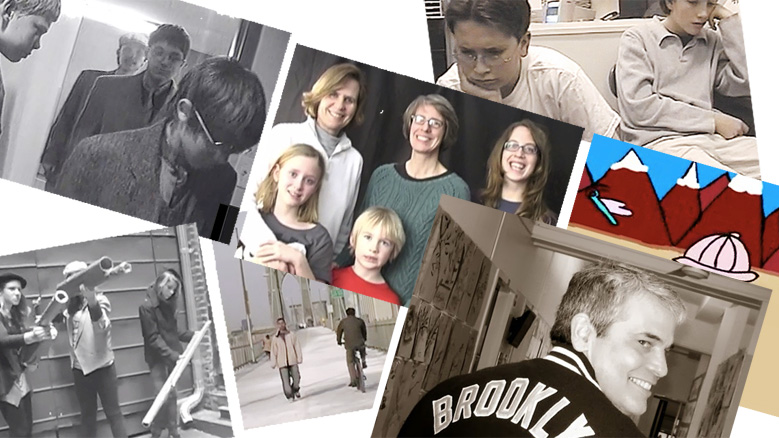 An Interview with Andrew Cohen of Brooklyn Friends School
An Interview with Andrew Cohen of Brooklyn Friends School
What was the inspiration for the Bridge Film Festival, and how did it start?
When I first started teaching video production at Brooklyn Friends School 15 years ago, I didn’t really know anything about Quakerism or how it related to teaching at a school. The kind of films my students wanted to make were pretty much what they were seeing on television and often included themes of sex and violence. I thought it was especially strange because I was in a Quaker school.
I thought there should be some guidelines for student filmmaking and expression and decided they should reflect Quaker “values in action.” That gives you a lot of leeway, but it is a foundation to work from. I formed a committee at Brooklyn Friends School and applied for a grant from the Friends Council on Education and a matching grant from my school. We weren’t necessarily looking for films about Quakerism; we wanted to encourage a collaboration between the faculty and students, and a discussion about what Quaker values mean for our schools.
What has changed over the years?
It began as a simple event. Schools sent in films, and we’d have a few judges and maybe a speaker at a festival that took place at the Brooklyn Friends School. As time went on, we added on workshops. It became a weekend event, with other schools driving up to participate.
A few years into the event, I received an email from a Quaker who was rather upset that her filmmaker son couldn’t enter the festival because he didn’t attend a Friends School (they couldn’t afford one). I spoke to my committee, and we quickly decided that this student should be able to enter the festival. We changed the rules, and now meetings can send in films for students that are part of their community.
For the ten-year anniversary of the festival in 2009, I arranged for the film festival to be held at the Ackworth School in West Yorkshire, England. When the faculty member coordinating it unexpectedly left for another job, I was able to use YouTube and Google Docs to plan it from Brooklyn, but still host it at Ackworth.
YouTube didn’t even exist 15 years ago. How have these changes in online sharing changed the festival?
The biggest change in the last five years is that now the whole process takes place online. Schools upload videos to YouTube and fill out an online form. Every entry that meets the criteria of the festival is available on our channel. Previous to this, the worst day of the film festival year for me had been the day I contacted schools to tell them that their film didn’t make the cut for the film festival. Now, we don’t have the same disappointment because all of the films are available to watch online.
We average about 20 to 25 or more films every year. If there’s a film festival event at Brooklyn Friends, or any other school or Quaker meeting, people can see these films online and create their own playlists that fit their own audience. For example, if a middle school out in Iowa wanted to have an assembly to showcase the films, and even do some judging themselves, they could pick the middle school selections. The same thing could happen with an upper school or meeting.
Has the technology changed the kind of entries that are created or their content?
If someone wants to make a film, he or she is going to make it, and it doesn’t matter what tools there are. At the beginning, we had three categories: narrative films, documentary films, and public service announcements. A few years ago we started getting films that weren’t traditional narratives or documentaries. They might be more statements of feeling; those fit better into what we now call “new media.”
Walk us through how a typical entry video gets produced.
There’s no one typical way. It often begins with the individual passion of that one kid who has an idea and is already engaged in filmmaking. A number of schools have fairly robust video programs, with curricula that specify that productions meet the criteria of the festival.
Sometimes it’s done out of a need in the community. For instance, Minnesota Friends were active speaking out against a proposed marriage amendment that would have affected same-sex couples. The eighth graders made a great video statement that they only later realized fit the criteria of the festival.
At Brooklyn Friends, we have a student activity group called Young Women of Strength. They produced a video that shows a typical day for a young woman and the issues she has to deal with in our modern society.
Does the act of writing, acting, or producing a film that explicitly focuses on Quaker values reinforce them in a way that other types of standard classroom activities don’t?
An educational system called Bloom’s Taxonomy ranks types of intellectual activity into a triangle of learning. At the top is creating. If you can understand a problem and communicate that problem to someone else, you’ve reached the highest level of the ability to learn something.
A teacher can define a value or a testimony all they want, but what’s more important is how an student understands and feels about that testimony. Everyone has to consider and reflect on the idea of these testimonies. That’s where the real gold comes from in our discussions of the Quaker relevancy of a particular film. It makes students think, which is the hardest thing to do.
Students can contribute to a production in many ways. Somebody might be a very good writer, another a good photographer, another a good actor. It’s very beneficial to see what each of these members of the team making a film can give to it.
A few of the filmmakers have been inspired by the festival to seek careers in film, but I’m just as happy to hear from folks who have made films and gone on to do other wonderful things too. These skills are transferable to almost any field you go into.
Have there been interesting discussions about “Quaker values” from the students or the teachers?
We evaluate film entries based on communication skill, creativity, technical quality, originality, but also Quaker relevancy. This last one is always the interesting one on the evaluation form.
I will sometimes show a film and ask students and faculty to rate it on Quaker relevancy. They might give it the lowest score Quaker relevancy, and I’ll counter “Actually, I think this is the most relevant.” Students and faculty will ask what I mean, and I’ll turn it around, “I know what I mean; what do you think I mean?” and then there’s a real discussion.
Are there particular videos that stand out? Did any of them have a profound effect on you personally or on your spirituality?
Now I’m going to have to re-watch all of these films again!
The first entry I received had an incredible effect on me. It came from a George School student named Jody Lee Lipes, who has since gone on to become a director and cinematographer. His film was a simple reflection of what it means to attend a Quaker school.
A few years later, a film called Focus came in from Delaware Valley Friends School. The film starts off as a discussion among four characters, who turn out to be four different parts of one person’s personality. They are dealing with issues arising from Attention Deficit Disorder. It was beautifully acted and written by this one student.
Two Students, Two Schools was a life-changing event for me. It was a collaboration between Brooklyn and Ramallah Friends Schools in Palestine. Since they didn’t have a video teacher, I traveled there to work on their portion. It was a tremendous experience, and I’m still in contact with student collaborators from both schools.
About five years ago, Friends School in Hobart, Australia, produced a film on global warming. It’s about a girl trying to run outside. It turns out she’s living in a dome, because that’s the last place you can live on the planet—inside a sphere.
It doesn’t matter if the film is ten minutes long or a 30-second public service announcement, it can be a great film that affects audiences.
Are there any special events planned for the fifteenth anniversary?
Because this has been the fifteenth year of the festival, I decided to be a little more adventurous. Over fall break, I went back to England and presented the film festival to classes in three schools. It was a wonderful experience. I believe all of these schools will be participating this year. These schools host an event called the Foxtrot every September, in which a group of students go on a three-day pilgrimage to northern England. Brooklyn Friends has been invited to participate in the next one; that’s a bridge that has been made. London-area schools have also contacted me about possible student exchanges with Brooklyn Friends.



Comments on Friendsjournal.org may be used in the Forum of the print magazine and may be edited for length and clarity.